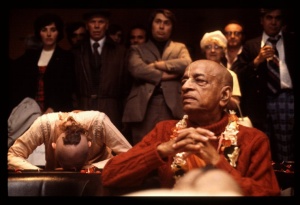CC Antya 1.161 (1975)

A.C. Bhaktivedanta Swami Prabhupada
TEXT 161
- parāmṛṣṭāṅguṣṭha-trayam asita-ratnair ubhayato
- vahantī saṅkīrṇau maṇibhir aruṇais tat-parisarau
- tayor madhye hīrojjvala-vimala-jāmbūnada-mayī
- kare kalyāṇīyaṁ viharati hareḥ keli-muralī
SYNONYMS
parāmṛṣṭā—measured; anguṣṭha-trayam—a length of three fingers; asita-ratnaiḥ—with valuable indra-nīla jewels; ubhayataḥ—from both ends; vahantī—having; saṅkīrṇau—bedecked; maṇibhiḥ—by gems; aruṇaiḥ— rubies; tat-parisarau—the two ends of the flute; tayoḥ madhye—between them; hīra—with diamonds; ujjvala—blazing; vimala—pure; jāmbūnada-mayī—covered with gold plate; kare—in the hand; kalyāṇī—very auspicious; iyam—this; viharati—glitters; hareḥ—of Kṛṣṇa; keli-muralī—the pastime flute.
TRANSLATION
The flute of Kṛṣṇa's pastimes measures three fingers in length, and it is bedecked with indra-nīla gems. At the ends of the flute are aruṇa gems [rubies], glittering beautifully, and in between the flute is plated with gold, set ablaze by diamonds. This auspicious flute, pleasing to Kṛṣṇa, is glittering in His hand with transcendental brilliance.'
PURPORT
This verse from Vidagdha-mādhava (3.1) is spoken to Lalitādevī by Paurṇamāsī, the grandmother of Rādhārāṇī.